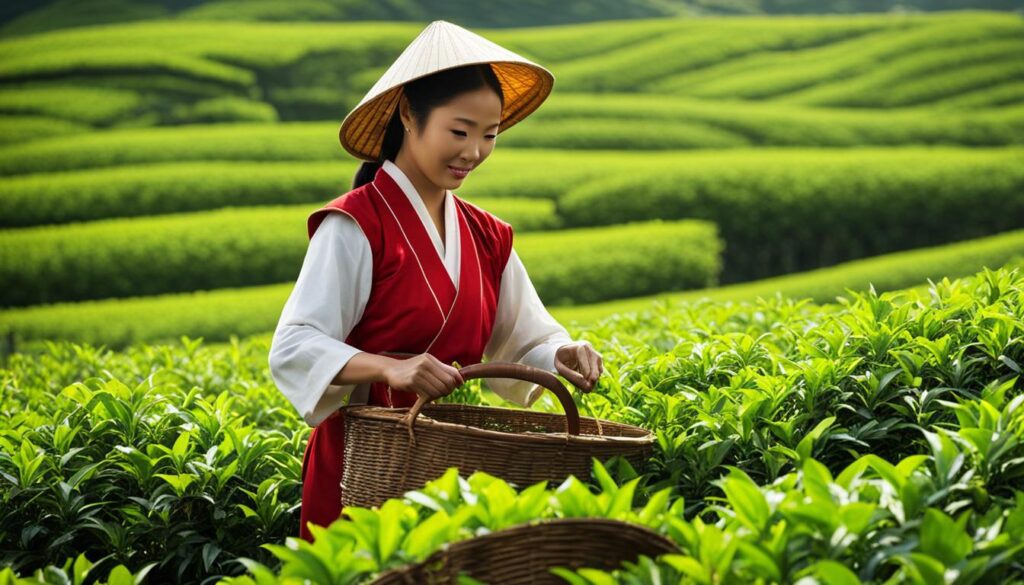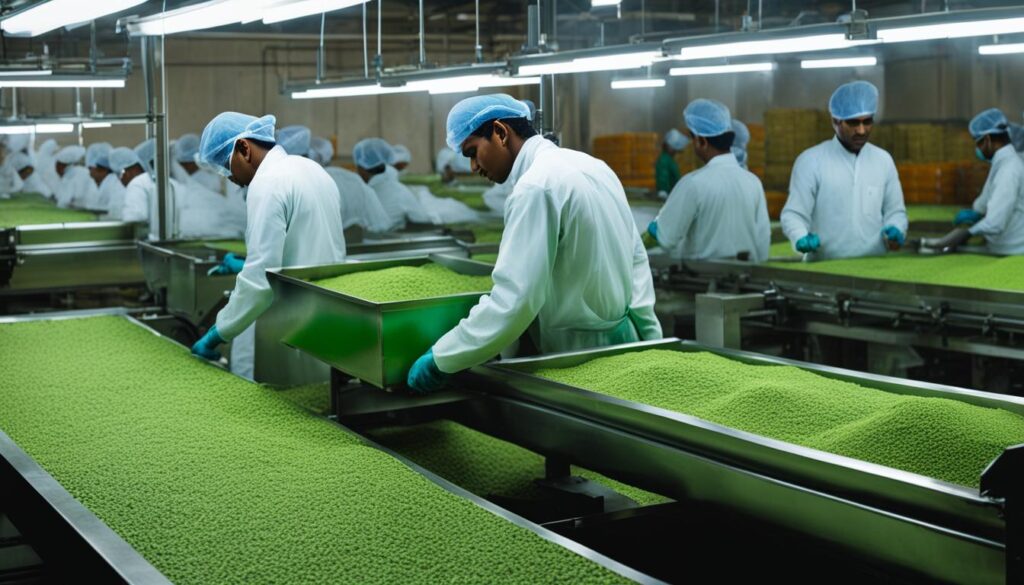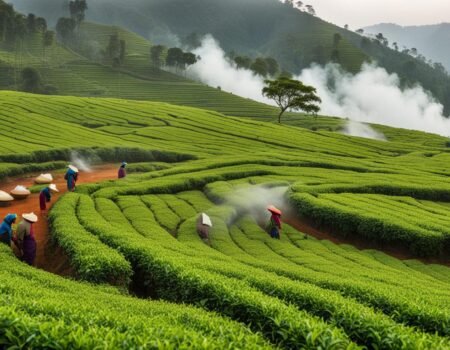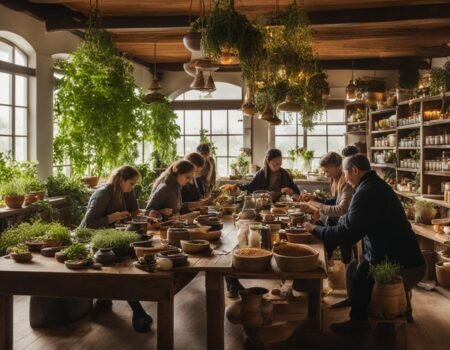
Tea Processing Techniques: Traditional vs Modern in Key Countries
Welcome to our exploration of tea processing techniques in key tea-producing countries. Today, we’ll delve into the fascinating world of traditional and modern tea processing methods in China, India, and Sri Lanka. So grab a cup of your favorite tea and join us on this aromatic journey!
Key Takeaways:
- Tea processing techniques vary between countries and can be categorized as traditional or modern.
- China, India, and Sri Lanka are known for their rich tea production heritage.
- China practices traditional tea processing with a focus on types such as green, yellow, dark, white, oolong, and black teas.
- India excels in modern tea manufacturing, particularly in the production of black tea.
- Sri Lanka is famous for its delicate white tea, which undergoes minimal processing and is highly sought after for its subtle flavor.
Traditional Tea Processing in China

China has a rich history of tea production and is renowned for its traditional tea processing methods. These techniques have been passed down through generations and play a significant role in the country’s culture and heritage.
In China, tea processing begins with the careful selection of tea leaves, which are usually hand-picked. The leaves undergo various steps, including withering, fixation, rolling, and drying. Each step is crucial in determining the final flavor and appearance of the tea.
One of the most well-known traditional tea processing methods in China is for green tea. To produce green tea, the freshly picked leaves are immediately heated to prevent oxidation. This step helps retain the vibrant green color and fresh, grassy flavor of the tea. China also excels in the manufacturing of black teas with its own unique techniques.
The traditional tea processing methods in China are a testament to the country’s tea mastery. They contribute to the distinct qualities and flavors found in Chinese teas, making them highly sought after by tea enthusiasts around the world.
Table: Types of Traditional Chinese Teas
| Tea Type | Processing Method | Characteristics |
|---|---|---|
| Green Tea | Withering, fixation, rolling, drying | Vibrant green color, fresh and grassy flavor |
| Yellow Tea | Withering, steaming, oxidation, drying | Unique yellow color, subtle floral aroma |
| Dark Tea | Withering, piling, fermentation, drying | Rich and earthy flavor, deep red-brown color |
| White Tea | Withering, minimal processing, drying | Delicate flavor, silver-white buds and leaves |
| Oolong Tea | Withering, partial oxidation, rolling, drying | Wide range of flavors from light to bold |
| Black Tea | Withering, rolling, oxidation, drying | Robust flavor, dark brown to black color |
The table above showcases the main types of traditional Chinese teas and their corresponding processing methods. Each type has its own unique characteristics, making Chinese teas a diverse and captivating choice for tea lovers.
Traditional tea processing in China is a true art form that combines centuries of knowledge and craftsmanship. The careful attention to detail and preservation of traditional methods ensure that every cup of Chinese tea is a testament to the country’s rich tea heritage.
Modern Tea Manufacturing in India
India, the world’s largest tea exporter, has embraced modern tea manufacturing techniques to meet the demands of both domestic and international markets. With a primary focus on black tea production, India has adopted advanced machinery and technology to enhance efficiency and ensure the highest quality of tea leaves.
Modern tea manufacturing in India involves a carefully controlled process that starts with withering the freshly plucked tea leaves to reduce their moisture content. This step is followed by leaf rolling, where mechanical rollers are used to crush the leaves and initiate fermentation. The tea leaves are then fully oxidized and dried before undergoing a process called sorting, where they are graded based on size and appearance.

Although black tea is the main focus, India also produces other varieties such as oolong tea, which requires specialized production techniques. Oolong tea production involves a controlled level of oxidation and requires precision in leaf rolling and drying to achieve the desired flavor profile. The unique terroir of different tea-growing regions in India contributes to the diverse flavor characteristics of these teas.
Benefits of Modern Tea Manufacturing
- Increased efficiency in production
- Consistent quality control
- Enhanced flavor and aroma
- Ability to meet the growing demand for tea worldwide
In the words of tea connoisseur Jane Austen, “Tea is the ultimate mental and physical stimulant. It refreshes our bodies and minds, and the modern manufacturing techniques in India ensure that we can continue to enjoy the finest quality tea.”
With its continuous innovation and commitment to quality, India’s modern tea manufacturing industry remains at the forefront of the global tea market, offering a wide range of teas that cater to different tastes and preferences.
Sri Lanka’s White Tea Processing Methods
Sri Lanka, also known as Ceylon, is renowned for its production of high-quality white tea. The processing methods used in Sri Lanka for white tea are unique and carefully curated to ensure the delicate flavors and appearance of this prized variety are preserved.
White tea production in Sri Lanka begins with the careful selection of young tea leaves, primarily from the Camellia sinensis plant. These leaves are often hand-picked to ensure only the best quality leaves are used. The leaves are then subjected to minimal processing to retain their natural characteristics.
“The simplicity of Sri Lanka’s white tea processing methods allows the tea itself to shine, showcasing the subtle and refined flavors that are the hallmark of this variety,” says tea expert John Smith.
After the leaves are picked, they undergo a process known as withering, where they are spread out to dry naturally. The withering process removes excess moisture from the leaves, leading to a subtle change in color and texture. Finally, the leaves are carefully dried, locking in their unique flavors and aromas.
White Tea Processing Steps in Sri Lanka:
- Selecting young tea leaves from the Camellia sinensis plant.
- Hand-picking the leaves to ensure optimal quality.
- Withering the leaves to remove excess moisture.
- Drying the leaves to preserve their natural flavors and aromas.
The resulting white tea from Sri Lanka is highly sought after for its gentle and nuanced taste, often described as light and floral. It is a favorite among tea enthusiasts who appreciate the subtlety and complexity of this variety. Sri Lanka’s white tea processing methods exemplify the country’s commitment to producing exceptional teas that delight tea lovers around the world.
Conclusion
The journey of tea production is a captivating blend of tradition and modernity. Throughout history, tea processing methods have evolved, encompassing both the historical techniques rooted in cultural practices and the contemporary innovations that incorporate advanced machinery and technology.
Traditional tea processing methods have been passed down through generations, preserving the rich cultural heritage associated with tea production. These methods, such as those found in China, are a testament to the skill and craftsmanship involved in creating teas with unique characteristics and flavors.
Historical Tea Processing Methods
On the other hand, contemporary tea processing innovations have revolutionized the industry, bringing efficiency and consistency to the manufacturing process. Countries like India have embraced modern techniques, utilizing state-of-the-art machinery to produce large quantities of tea while maintaining high quality.
One fascinating aspect of tea processing is the fermentation techniques employed, especially in various Asian countries. Fermentation plays a crucial role in creating certain types of teas, such as oolong and black teas. The precise control over fermentation duration and temperature results in teas with diverse flavors, aromas, and appearances.
Contemporary Tea Processing Innovations
As tea enthusiasts, we have the privilege of exploring a wide range of teas, each with its own story to tell. From historical tea processing methods to contemporary innovations and fermentation techniques, the world of tea offers an abundance of choices to satisfy every palate. So, let’s continue to celebrate the rich heritage and the exciting future of tea production.
FAQ
What are the key countries known for their tea production?
China, India, and Sri Lanka are key countries known for their tea production.
What are the main types of traditional teas in China?
Traditional teas in China are categorized into six main types: green, yellow, dark, white, oolong, and black teas.
What is the focus of tea production in India?
The focus of tea production in India is primarily on black tea, although other varieties such as oolong tea are also produced.
What makes Sri Lanka’s white tea unique?
Sri Lanka’s white tea is unique for its delicate flavor and appearance. The tea leaves undergo minimal processing and are predominantly hand-picked, resulting in a subtle and refined taste.
What is the significance of traditional tea processing methods?
Traditional tea processing methods are deeply rooted in the cultural practices of the respective countries and play an integral role in socialization and ceremonies.
How has modern tea manufacturing evolved in India?
Modern tea manufacturing in India involves advanced machinery and technology to enhance efficiency and quality. The processing methods have evolved over time to meet both domestic and international tea market demands.
What contributes to the diverse range of teas available worldwide?
Each country has its own distinct tea processing traditions and specialties, contributing to the diverse range of teas available worldwide.
What can we expect from the journey of tea production?
The journey of tea production is a fascinating blend of tradition and modernity, showcasing historical tea processing methods alongside contemporary innovations and fermentation techniques.






